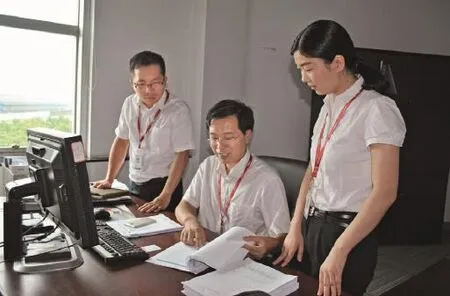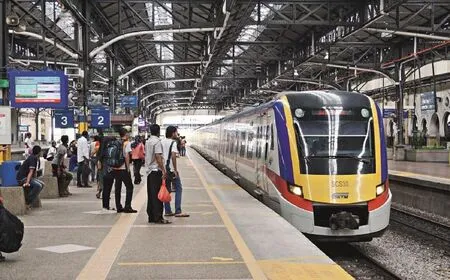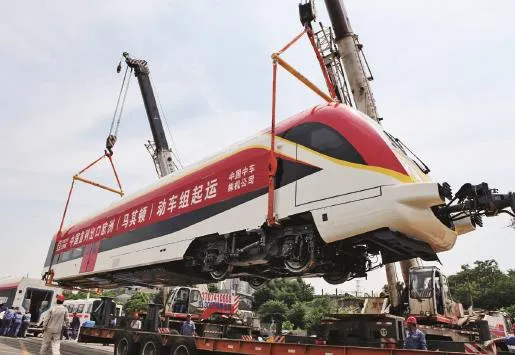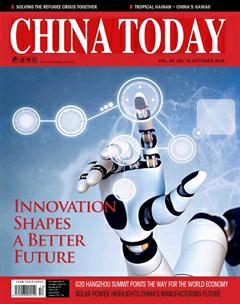Zhou Ande: Innovator of Meter Gauge Trains
By staff reporter DANG XIAOFEI
Zhou Ande: Innovator of Meter Gauge Trains
By staff reporter DANG XIAOFEI
ON the meter gauge railway of Kuala Lumpur, capital of Malaysia, an electric multiple unit (EMU) runs at a speed of 160 km per hour. Compared with the speed of over 300 km per hour of high-speed trains, many would argue that this is not fast. However,for this type of track, it is the fastest in the world.
A standard railway track is 1,435 mm wide, whereas the meter gauge, or narrow gauge, is 1,000 mm. Because Malaysia was once a British colony,existing rails in use are of the narrow gauge. The EMU running on a meter gauge track is like trying to sprint on a balance beam, requiring a great deal of maintenance of stability for comfort when running at high speed.
Zhou Ande, one of the designers of this EMU in Malaysia, is the head of the Research and Development Department of the Motor Train Unit of CRRC Zhuzhou Locomotive Co., Ltd.(CRRC Zhuzhou). In his 20-year R&D career, Zhou has been dedicated to train safety and speed. According to him, innovation never stops.

Zhou Ande and his team work on the meter gauge railway project in Malaysia.
INNOVATION
In his 20-year R&D career,Zhou has been dedicated to train safety and speed. According to him,innovation never stops.
Chasing a Dream
When I arrived at Zhou’s lab, he was measuring the noise level of the EMU when running at high speed on meter gauge tracks in an isolated space. The lab bears witness to his industrious efforts and his dream of the EMU.
In 1958 the predecessor to CRRC Zhuzhou, Hunan Zhuzhou Locomotive Factory, produced China’s first electric locomotive Shaoshan. Born in the 1970s in Hunan, Zhou grew up listening to the story of Shaoshan. It inspired his desire to explore the locomotive’s power, and the seeds of a dream began to germinate.
His keen interest in the locomotive made Zhou choose electric traction as his college major. After graduating from Southwest Jiaotong University in 2000, Zhou worked at what is now CRRC Zhuzhou Locomotive Co., Ltd. It is a company dedicated to electric locomotives, intercity EMU, magnetic levitation trains and rail vehicles featuring new technologies.
Upon entering the company Zhou was assigned to the technical services section of the Guangzhou-Shenzhen Railway project. It was the first time he had made contact with the motor train unit. As to the births of the “Lanjian (blue arrow),” an electric-powered train for the Guangzhou-Shenzhen line, and “China Star” EMU, whose speed was 321.5 km per hour, the fastest on the Chinese railway at that time, Zhou accumulated experience in research on motor train units.
The proposed development plan of urban agglomeration and urban pas-senger transport made Zhou change his research to that on the intercity motor train unit, which laid foundations for the world’s fastest EMU.
“At that time, no one had studied the operation of trains on intercity lines,though the high-speed railway had been imported,” Zhou recalled. “Different than high-speed rail, intercity EMU applies a public transport operation mode characterized by shorter distances and a large flow of passengers.”
Thanks to several years of efforts,Zhou had the opportunity to realize his dream. CRRC Zhuzhou signed a RMB 4 billion order with Malaysia for electrical multiple units. This marked the country’s first exports of China-made multiple units of electric traction. The first order to Malaysia was for 38 EMUs running on meter gauge track. The design of these “bullet head” trains emulates the Islamic style.
After completion of the first order,the Malaysian side immediately signed a second. Based on his experience, Zhou made innovations to EMUs running on meter gauge track. They thus became the world’s fastest of that kind.

An intercity locomotive designed by Zhou Ande in Kuala Lumpur, capital of Malaysia.
Technical Difficulties
Upon being given the task of research and design, Zhou felt great pressure due to the importance of the project. As a peninsula between the Indian Ocean and South China Sea, Malaysia is hot and humid. The average temperature is above 35 degrees Celsius all year round. The Malaysian party required the temperature inside the wagons to average 19 degrees, which represented a major challenge as regards air-conditioning systems.
“If the technology is not up to scratch,condensate water cascades over the outside of the wagon when the train moves,”said Zhou. To solve this problem, Zhou and his team improved the cooling capacity, moisture removal and drainage. Finally they overcame this difficulty to the satisfaction of the Malaysian client.
Old electric trains in Malaysia temporarily lose power when passing neutral sections, causing great inconvenience to passengers. The photovoltaic integration technology installed in China-made wagons ensures a continuous power supply. The air-conditioning, lights and television hence work normally when the EMU passes through places with no electricity.
Another challenge for Zhou and his team was the large passenger volume.Trains with six wagons carry more than 1,200 passengers, and there is a train every seven to 15 minutes. “This is a great challenge for the operation of the power system and bogie,” said Zhou.
After researching for several days and nights using wheel-disk braking bogie technology, Zhou and his team managed to get the train to stop at a distance of one km within 90 seconds. “This technique was first introduced in China,”Zhou explained. So the bogie, just like a car chassis, serves to steer, support the body of the car and absorb the impact at the same time.
Zhou also explained that the train body is made of high-strength aluminum alloy, and it takes only two minutes after the train starts to reach a speed of 160 km per hour. In addition to the design that ensures the safety of the EMU throughout its operation, modern systems such as an axes temperature alarm system, a horizontal stabilizing device,and a monitoring system for situations outside the train, provide security sufficient for the train to move at high speed.
The interior of train units that run on meter gauge track is also designed to cater to local Malaysian factors. Ladies only wagons are installed, and there is also a prayer booth for long journeys.
Zhou emphasized that technological innovation is the main reason for his company’s success in Malaysia. In his opinion, technical innovation performs a vital organic function. “Human beings cannot live without blood circulating their systems, and without innovation the CRRC Zhuzhou can achieve little in Malaysia.”
In order to generate more orders, according to Zhou, continuous innovations are urgently needed to products’ technical performance. “China’s trains and relevant technologies are at the same level as that of top players in the sector.
COOPERATION
"Human beings cannot live without blood circulating their systems, and without innovation the CRRC Zhuzhou can achieve little in Malaysia." However, our products are closer to customer demands.”

An EMU produced by CRRC Zhuzhou bound for Europe.
As for the criticism that China “mimics” foreign technology with its highspeed trains, Zhou replied: “If after introducing foreign technology we can improve it, is that still ‘imitation’?” The CRRC trains for Malaysia adopt European and International Union of Railways standards, and have passed third-party design, production and testing evaluation for meter gauge tracks. They set the world record of 176 km per hour during a 10,000 km glitch-free test run.
Going Global
During his visits to Malaysia, many locals asked Zhou: “China is a backward country, so how is it possible to sell electric multiple units to us?”
At first the Malaysian government lacked confidence in CRRC Zhuzhou.“The slightest fault in trials would worry the Malaysian client,” Zhou said. In one case, signal interference grounded the train, but the Malaysian side believed that it was a problem with the EMU.
Zhou led his technicians to check the wires on the railroad and discovered the problem: most of the cables were copper, and had been stolen, which led to signal interference. “We checked along the railway line, meter by meter, in the Malaysian heat,” Zhou said. Breakdowns stopped after the cables were mended,and the EMU progressed normally. This gained the trust of the Malaysian side.
Trust helps deepen cooperation. At present, more than 80 percent of railroad transport equipment in Malaysia comes from CRRC Zhuzhou. The company also has three subsidiaries in Malaysia and 90 percent of their employees are locals.
Besides Malaysia, CRRC Zhuzhou has received orders from more than 10 countries - among them Singapore,Turkey, India, South Africa, Macedonia, and Ethiopia. These orders cover locomotives, subways, tram-trains, and EMUs. The value of orders amounts to more than RMB 30 billion. CRRC Zhuzhou has exported products to 101 countries and regions. All these achievements are testimony to its high level of innovation.

